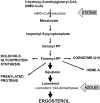Candida glabrata, Friend and Foe
- PMID: 29376912
- PMCID: PMC5753114
- DOI: 10.3390/jof1020277
Candida glabrata, Friend and Foe
Abstract
Candida glabrata is mostly good, but, at times, it is an opportunistic pathogen. Previously known as Torulopsis glabrata, it enjoyed a good reputation and was even present in starter cultures. Its haploid genome and lack of mating made it an attractive challenge for yeast genetics studies. However, more recently it has become better known due to its character as an emerging cause of candidiasis, and for its resistance to multidrugs that are employed for candidiasis treatment. While now classified as Candida glabrata, it is still not a good fit and tends to stand alone as a very unique yeast. In terms of sequence, it is dissimilar to other Candida yeast and most similar to Saccharomyces cerevisiae.
Keywords: Torulopsis; antifungal resistance; azole; candidiasis; ergosterol; opportunistic pathogen; starter culture; statins; yeast.
Conflict of interest statement
The authors declare no conflict of interest.
Figures
Similar articles
-
Discriminative power of fatty acid methyl ester (FAME) analysis using the microbial identification system (MIS) for Candida (Torulopsis) glabrata and Saccharomyces cerevisiae.Diagn Microbiol Infect Dis. 2000 Dec;38(4):213-21. doi: 10.1016/s0732-8893(00)00205-4. Diagn Microbiol Infect Dis. 2000. PMID: 11146246
-
Candida and candidaemia. Susceptibility and epidemiology.Dan Med J. 2013 Nov;60(11):B4698. Dan Med J. 2013. PMID: 24192246 Review.
-
Candida glabrata: a deadly companion?Yeast. 2014 Aug;31(8):279-88. doi: 10.1002/yea.3019. Epub 2014 Jun 13. Yeast. 2014. PMID: 24861573 Review.
-
Evidence that Ergosterol Biosynthesis Modulates Activity of the Pdr1 Transcription Factor in Candida glabrata.mBio. 2019 Jun 11;10(3):e00934-19. doi: 10.1128/mBio.00934-19. mBio. 2019. PMID: 31186322 Free PMC article.
-
Expression of Efflux Pumps and Fatty Acid Activator One Genes in Azole Resistant Candida Glabrata Isolated From Immunocompromised Patients.Acta Med Iran. 2016 Jul;54(7):458-64. Acta Med Iran. 2016. PMID: 27424018
Cited by
-
Thymoquinone Antifungal Activity against Candida glabrata Oral Isolates from Patients in Intensive Care Units-An In Vitro Study.Metabolites. 2023 Apr 21;13(4):580. doi: 10.3390/metabo13040580. Metabolites. 2023. PMID: 37110238 Free PMC article.
-
Role of CgTpo4 in Polyamine and Antimicrobial Peptide Resistance: Determining Virulence in Candida glabrata.Int J Mol Sci. 2021 Jan 29;22(3):1376. doi: 10.3390/ijms22031376. Int J Mol Sci. 2021. PMID: 33573089 Free PMC article.
-
Genomic Assembly of Clinical Candida glabrata (Nakaseomyces glabrata) Isolates Reveals within-Species Structural Plasticity and Association with In Vitro Antifungal Susceptibility.Microbiol Spectr. 2022 Dec 21;10(6):e0182722. doi: 10.1128/spectrum.01827-22. Epub 2022 Nov 10. Microbiol Spectr. 2022. PMID: 36354359 Free PMC article.
-
Brazilian Copaifera Species: Antifungal Activity against Clinically Relevant Candida Species, Cellular Target, and In Vivo Toxicity.J Fungi (Basel). 2020 Aug 28;6(3):153. doi: 10.3390/jof6030153. J Fungi (Basel). 2020. PMID: 32872100 Free PMC article.
-
Gut and bladder fermentation syndromes: a narrative review.BMC Med. 2024 Jan 22;22(1):26. doi: 10.1186/s12916-023-03241-7. BMC Med. 2024. PMID: 38246992 Free PMC article. Review.
References
-
- Hommel R.K. Encyclopedia of Food Microbiology. 2nd ed. Academic Press; San Diego, CA, USA: 2014. Torulopsis; pp. 596–602.
-
- Sinnott J.T., Cullison J.P., Sweeney M.P. Candida (Torulopsis) glabrata. Infect. Control. 1987;8:334–336. - PubMed
Publication types
LinkOut - more resources
Full Text Sources
Other Literature Sources



